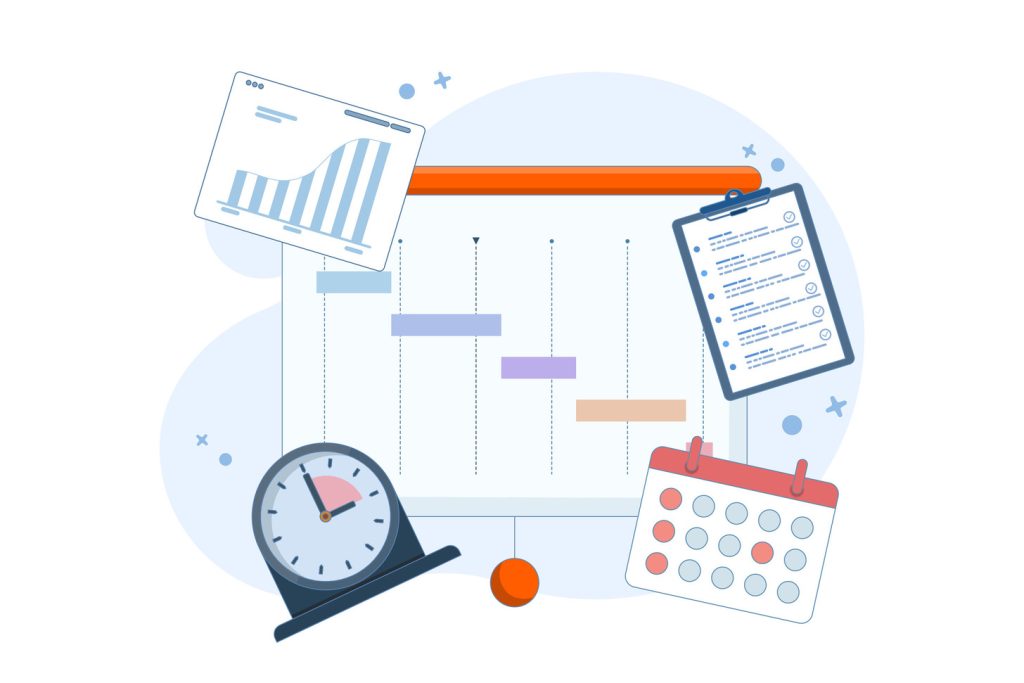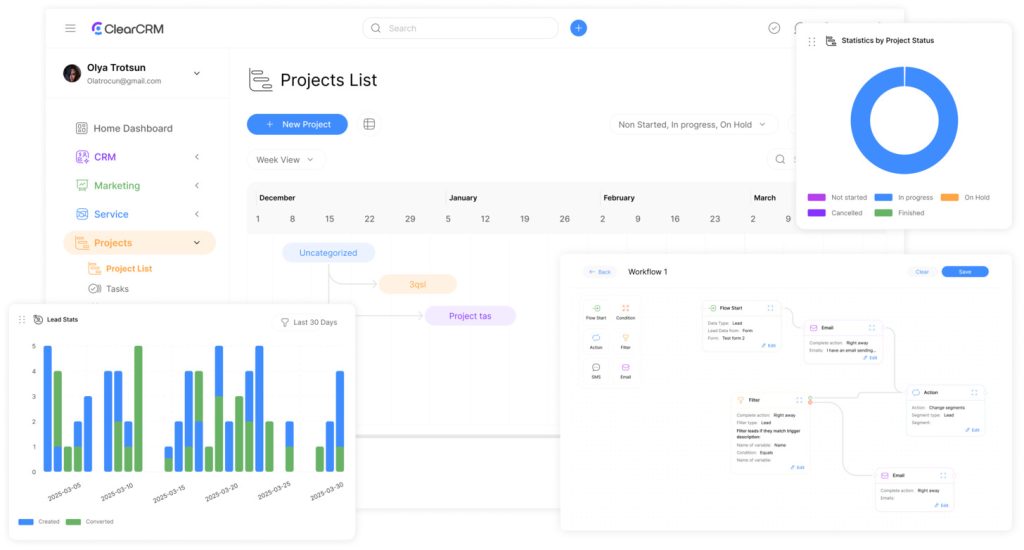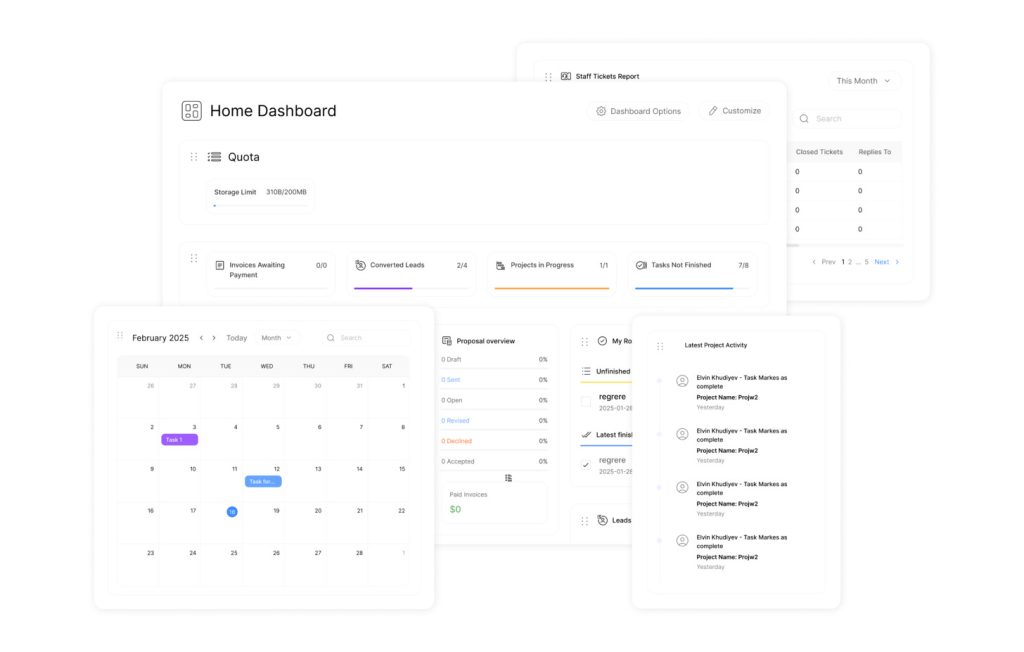Effective Project Planning & Management Techniques

Turning complex tasks into organized processes is the foundation of successful project Planning. Effective project planning & management transforms scattered efforts into measurable outcomes by aligning project teams, resources, timelines, and project scope. This approach reduces wasted effort while maximizing clarity and progress at every phase.
Establishing clear project objectives early creates a project plan that anticipates risks and allocates resources effectively. Organizations using systematic project management software report 34% fewer delays compared to those relying on reactive approaches. Tools like Asana, Monday.com, or ClearCRM improve visibility, helping stakeholders track progress without constant micromanagement.
Strategic frameworks build resilience against unexpected changes. Proactive risk management identifies potential threats before they escalate, protecting budgets, schedules, and deliverables. Companies adopting structured project management practices report 28% fewer budget overruns and achieve 19% faster completion rates.
Key Takeaways
- Structured methods convert chaotic workflows into repeatable processes
- Early goal-setting prevents scope creep and aligns team priorities
- Risk analysis tools minimize disruptions and protect timelines
- Collaboration platforms improve visibility across distributed teams
- Measurable benchmarks enable continuous performance improvement
Introduction: The Importance of Effective Project Planning & Management

Organizations that master the alignment of vision and action consistently outperform competitors. Without structured project management frameworks, teams face confusion, missed deadlines, and dissatisfied clients. Modern approaches convert abstract goals into actionable project plans, balancing timelines, resources, and risk management.
Research shows that teams who clearly understand their role in achieving project objectives are twice as motivated. Yet only 26% of employees receive clear direction. Strategic project planning & management fills this gap by creating accountability, eliminating redundant tasks, and demonstrating how daily efforts contribute to business growth. Project management software like ClearCRM facilitates this by providing real-time visibility across project teams and stakeholders.
Organizations adopting modern project management practices experience fewer budget overruns, faster delivery cycles, and 19% higher customer satisfaction rates. Proactive risk management reduces bottlenecks, while collaborative project management software ensures smooth workflows without last-minute crises.
Key advantages include:
- Converting vague ideas into step-by-step action plans
- Reducing operational chaos that erodes stakeholder trust
- Boosting team productivity through purpose-driven workflows
Modern strategies go beyond ticking off tasks. They ensure every initiative supports long-term objectives, turning isolated efforts into engines for sustainable success.
Understanding the Project Lifecycle and Framework
Navigating complex initiatives requires a roadmap that balances flexibility with structure. Teams often struggle when jumping into action without clarifying foundational elements first. A phased approach creates guardrails for progress while allowing adaptability as circumstances evolve.
From Initiation to Closure
The initiation stage acts as a reality check. Teams define measurable objectives and assess feasibility through stakeholder interviews and resource audits. One study found organizations that spend 15% more time here reduce mid-cycle revisions by 41%.
| Phase | Focus Area | Critical Outcome |
|---|---|---|
| Initiation | Objective validation | Approved business case |
| Strategic Design | Resource mapping | Actionable blueprints |
| Delivery | Task execution | Tangible deliverables |
| Oversight | Performance tracking | Course corrections |
| Completion | Knowledge transfer | Stakeholder sign-off |
During delivery phases, real-time tracking tools become essential. Platforms like Asana or Monday.com provide visibility into task dependencies, helping teams maintain momentum. As workflow expert Linda Torres notes:
“The best frameworks act like GPS systems—they show where you are, not just where you should go.”
Closure rituals often get overlooked but prevent recurring mistakes. Conducting retrospectives and archiving documentation enables continuous improvement. Teams using this practice report 27% faster ramp-up times on subsequent efforts.
Defining Project Objectives, Goals, and Scope

Clear direction separates successful outcomes from chaotic efforts. Establishing precise targets and limits early creates a foundation teams can rely on when challenges arise. This clarity prevents wasted resources while keeping efforts aligned with strategic priorities.
Setting Clear Objectives
SMART criteria transform vague aspirations into actionable steps. Specific, measurable, achievable, relevant, and time-bound targets eliminate ambiguity. For example, “Increase client onboarding efficiency by 25% within Q3” beats generic goals like “Improve processes.”
Teams using SMART frameworks report 32% fewer miscommunications. As workflow strategist Linda Torres observes:
“Objectives without metrics are wishes. Measurable benchmarks turn intention into execution.”
Managing Scope Effectively
Boundaries protect timelines and budgets from expanding demands. A 2023 PMI study found 59% of derailed initiatives suffered from uncontrolled scope changes. Formal change control processes evaluate requests against original goals before approval.
| Scope Component | Focus | Tool Example |
|---|---|---|
| Initiation | Deliverable clarity | Requirement workshops |
| Execution | Change management | Jira workflows |
| Closure | Outcome validation | Stakeholder sign-off sheets |
Involving stakeholders during scope definition reduces mid-cycle revisions by 41%. Regular check-ins maintain alignment without stifling innovation. The balance? Firm guardrails with flexible implementation paths.
Developing a Comprehensive Project Plan
A blueprint bridges the gap between vision and reality. Detailed plans transform abstract goals into executable steps, outlining schedules, resources, and deliverables. Teams without this foundation often face misaligned priorities and missed deadlines. Research from the Project Management Institute confirms initiatives with thorough plans achieve success rates 28% higher than those without.
Effective strategies break complex efforts into sequential tasks. This systematic approach assigns ownership based on skills and availability. For example, marketing teams using task matrices reduce duplicated work by 37%. Clear timelines prevent bottlenecks while allowing flexibility for adjustments.
Key components of successful plans include:
- Phase-specific deliverables with quality benchmarks
- Resource allocation charts matching budgets to needs
- Contingency buffers for unexpected delays
Modern tools like Smartsheet or Trello visualize progress across teams. They automate updates, letting stakeholders track milestones without manual reports. As productivity expert Mark Lewis notes: “Plans that live in spreadsheets fail. Dynamic tools create living documents teams actually use.”
Regular reviews keep efforts aligned with changing priorities. Weekly check-ins identify deviations early, preserving timelines and stakeholder trust. Companies adopting this practice report 23% fewer last-minute scrambles.
Creating a Realistic Timeline and Schedule

Crafting a timeline that balances ambition with practicality determines whether teams sprint or stumble toward deadlines. Precise scheduling aligns team capacity with deliverables while accounting for dependencies. This clarity prevents bottlenecks and maintains stakeholder confidence through predictable progress.
Mapping Out Milestones and Deadlines
Milestones act as checkpoints to verify quality and adjust strategies. Teams using milestone-driven approaches report 31% fewer deadline extensions. A 2023 workflow study found initiatives with buffer time between phases completed 22% faster due to reduced pressure.
| Timeline Element | Purpose | Impact |
|---|---|---|
| Milestones | Mark phase completion | Track progress, boost morale |
| Task Dependencies | Define work sequence | Prevent bottlenecks |
| Buffer Time | Absorb delays | Protect deadlines |
| Critical Path | Identify key tasks | Focus resources |
Strategic scheduling requires analyzing team capacity and external constraints. Tools like Gantt charts visualize task relationships, helping managers spot conflicts early. Productivity expert Laura Chen notes: “Timelines without flexibility become liability lists. Build adaptability into every phase.”
Effective plans sequence tasks logically while reserving 10-15% of total time for adjustments. This approach reduces rework by 19% and keeps stakeholders informed through visible progress markers. Teams maintain momentum without burnout when schedules respect human and operational limits.
Budgeting, Resource Management, and Cost Control
Financial discipline separates predictable outcomes from chaotic spending patterns. Teams that master fiscal oversight deliver results without compromising quality or timelines. Three pillars drive success: strategic budgeting, intelligent resource distribution, and real-time expense tracking.
Optimizing Resource Allocation
Effective budget strategies start with granular cost analysis. Labor, materials, and equipment needs must align with organizational capacity. Contingency reserves—typically 10-15% of total budgets—absorb unexpected costs while protecting timelines.
Resource alignment requires matching skills to tasks. As workflow expert Laura Chen observes:
“Overstaffing drains funds. Understaffing delays results. Precision in team deployment creates financial and operational leverage.”
| Budget Phase | Key Action | Tool Example |
|---|---|---|
| Forecasting | Cost estimation | QuickBooks |
| Execution | Expense tracking | Expensify |
| Review | Variance analysis | Microsoft Power BI |
Continuous monitoring spots deviations early. Teams using automated dashboards reduce budget overruns by 29% compared to manual methods. Approval workflows ensure every financial change undergoes scrutiny before implementation.
Capacity planning prevents resource burnout. Cross-functional visibility tools help managers balance workloads across multiple initiatives. This approach cuts idle time by 18% while maintaining delivery speed.
Effective Risk Management and Mitigation Strategies

Anticipating challenges separates resilient operations from fragile ones. Proactive identification of potential threats allows teams to address issues before they escalate. This forward-thinking approach preserves timelines, budgets, and stakeholder confidence through systematic preparation.
Comprehensive analysis evaluates both probability and impact of risks. Teams using severity matrices prioritize threats needing immediate attention. For example, a manufacturing firm might rank supply chain disruptions higher than software glitches based on operational dependencies.
| Threat Category | Focus Area | Mitigation Example |
|---|---|---|
| Technical | System failures | Redundant backups |
| External | Regulatory changes | Compliance audits |
| Resource | Staff shortages | Cross-training programs |
| Stakeholder | Shifting priorities | Change control processes |
Mitigation strategies combine prevention and contingency planning. Preventive measures reduce occurrence likelihood, while backup plans minimize damage when risks materialize. Workflow expert David Park notes:
“Effective risk control isn’t about eliminating surprises—it’s about building response muscle memory.”
Continuous monitoring through dashboards provides early warnings. Teams using automated alerts resolve 43% of issues before they affect deliverables. This vigilance maintains momentum while allowing adaptive resource allocation.
Balancing mitigation costs against potential impact ensures proportional responses. Organizations adopting this principle report 22% higher ROI on protective measures. Regular strategy reviews keep defenses aligned with evolving factors.
Leveraging Project Management Software and Tools
The right digital tools transform how teams achieve objectives. Modern platforms centralize communication, task tracking, and progress updates in one interface. Solutions like Asana, ClickUp, and Wrike eliminate scattered spreadsheets while offering customizable views for different workflows.
Choosing the Right Tools for Your Needs
Selecting effective software starts with understanding team requirements. Does your workflow need Gantt charts for timelines or Kanban boards for agile sprints? User-friendly interfaces reduce learning curves, while integrations with existing systems prevent data silos. Top platforms balance flexibility with structure, adapting to unique processes without overcomplicating tasks.
Integrating Software into Your Workflow
Successful adoption requires more than installation. Training programs help teams master automation features and reporting dashboards. Linking tools to email, CRM systems, and cloud storage creates seamless data flow. This eliminates manual entry errors and ensures real-time accuracy across departments.
Advanced analytics within these platforms spot trends in team performance or budget use. Automated alerts notify managers about delays before they escalate. When implemented strategically, management software becomes a catalyst for smarter decisions—not just a task tracker.

